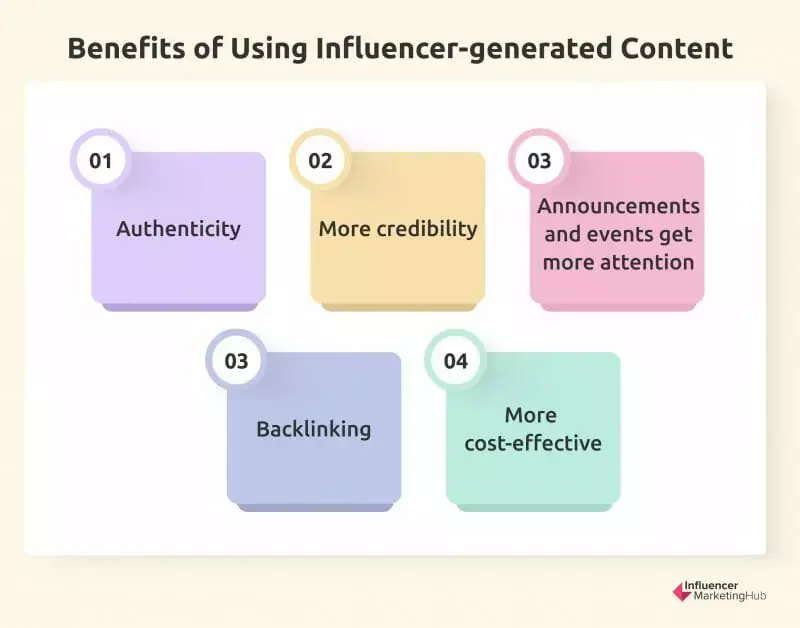In the highly competitive world of e-commerce, there are over 9.1 million etailers in the world (2.5 million in the US) vying for customer attention. With so many options available, users have the luxury to pick and choose from a variety of stores. According to the Baymard Institute, after customers go through the effort of browsing products, adding them to their cart, and proceeding to checkout, 2 out of 3 shoppers ultimately abandon their carts.
So, influencer marketing has emerged as a highly effective tool for eCommerce businesses to expand their customer base, elevate their brand visibility, and drive revenue.
There are a number of different ways to use influencer marketing for eCommerce. One common approach is to have influencers create product reviews or demonstrations. This can be a great way to show potential customers how your products work and what they can expect from them.
Another option is to have influencers host giveaways or contests that feature your products. This can be a fun and engaging way to generate excitement around your brand and attract new customers.
This approach has proven to be highly effective, with research indicating that 49% of users rely on recommendations from influencers on Twitter when making purchase decisions.
Moreover, influencer marketing campaigns have been found to offer an equal or even better ROI than other marketing channels like SEO or PPC, with 89% of marketers confirming this.
When done right, influencer marketing can be a very effective way to grow your eCommerce business. By partnering with the right influencers, you can reach new customers, build brand awareness, and drive sales.
Tips for Using Influencer Marketing for eCommerce:
1. Set clear goals and budget
What do you want to achieve with your influencer marketing campaign? Do you want to increase brand awareness, generate leads, or drive sales? Once you know your goals, you can start to develop a strategy to achieve them.
Also, influencer marketing can be costly, so it’s important to determine how much you can afford to invest and what kind of return you can expect on your investment.
2. Choose the right influencers to reach a niche audience
Not all influencers are created equal. When choosing influencers to partner with, it’s important to consider their following, their engagement rate, and their content style.
You want to make sure that the influencers you partner with have a following that is interested in the products or services you offer. You also want to make sure that the influencers’ content is high-quality and engaging.
Additionally, you need to:
- Use a variety of influencers: Don’t just partner with one or two influencers. Instead, use a variety of influencers with different audiences. This will help you reach a wider range of potential customers.
- Be creative: Don’t just have influencers post about your products or services. Get creative and think of new ways to use influencers to promote your brand. For example, you could have influencers host live Q&A sessions, create product tutorials, or even write blog posts about your brand.
Related: How to Get Trusted Bloggers to Review Your Product
3. Make the most of influencer-generated content
Influencers possess a unique talent for creating attention-grabbing content that sets them apart on social media. This is precisely why many brands are turning to influencers for visuals to feature on their own social media platforms.
Moreover, with the influencer’s consent, you can also incorporate their visuals in your paid ads. According to Meta, ads featuring influencer-generated content have a 53% higher click-through rate compared to those that use typical visuals.

Source: Influencer Marketing Hub
Also, it’s important to create a relationship with the influencers you partner with that is mutually beneficial. You want to make sure that the influencers are happy with the products or services you offer, and you want to make sure that they are happy with the content you create together.
Related: Visual Content Ideas to Enhance Your Brand Messaging
4. Continuously measure and optimize your results
It’s important to track the results of your influencer marketing campaigns so that you can see what’s working and what’s not. There are a number of influencer marketing tools that you can use to track your results, such as Google Analytics alternatives, Microsoft Clarity, and social media analytics tools.
Try the following steps to measure and improve your campaigns:
- Identify the metrics that are most relevant to your goals, such as engagement rates, click-through rates, or sales figures. Use tools like Google Analytics, social media insights, and influencer marketing platforms to track your metrics.
- Regularly review your metrics to understand how your influencer marketing campaigns are performing. Identify what’s working and what’s not, and use that information to make data-driven decisions about your influencer selection, content strategy, and budget allocation.
- Use the insights you gain from your data analysis to continually optimize your influencer marketing campaigns. Adjust your approach based on what’s resonating with your audience, and test new strategies to see what works best.
By continuously measuring and optimizing your influencer marketing campaigns, you can ensure that you’re getting the most value out of your investment and driving meaningful results for your eCommerce business.
See Also: How to Increase Sales Through Instagram Marketing
Conclusion
As the e-commerce industry continues to expand, it’s becoming increasingly crucial to find affordable advertising platforms that deliver results. One effective strategy is to offer customers discounts on products in exchange for Instagram posts, which can serve as powerful influencer marketing channels and help increase your brand’s visibility.
By providing discounted rates, you can encourage customers to try your products and potentially attract new customers who may have been hesitant to purchase at full price. Research has shown that discounts can also improve buying behaviors, such as increasing the average order value and boosting customer loyalty.





